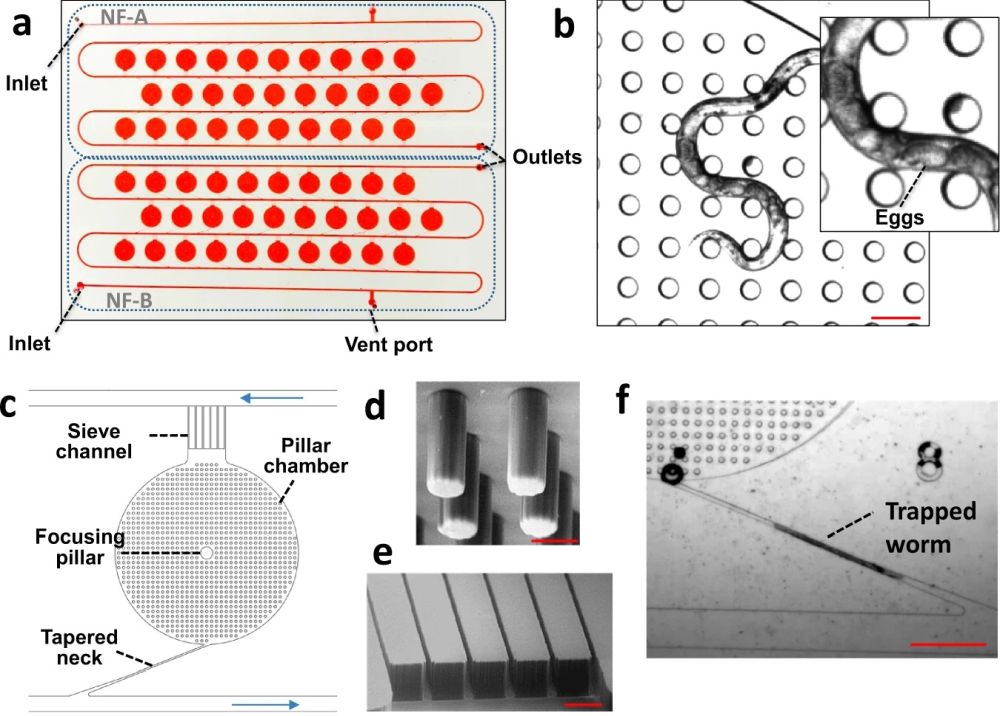
16 Nov Microfluidic device flown to the International Space Station to study C. elegans in microgravity environment
Abstract
“Caenorhabditis elegans is a low-cost genetic model that has been flown to the International Space Station to investigate the influence of microgravity on changes in the expression of genes involved in muscle maintenance. These studies showed that genes that encode muscle attachment complexes have decreased expression under microgravity. However, it remains to be answered whether the decreased expression leads to concomitant changes in animal muscle strength, specifically across multiple generations. We recently reported the NemaFlex microfluidic device for the measurement of muscle strength of C. elegans (Rahman et al., Lab Chip, 2018). In this study, we redesign our original NemaFlex device and integrate it with flow control hardware for spaceflight investigations considering mixed animal culture, constraints on astronaut time, crew safety, and on-orbit operations. The technical advances we have made include (i) a microfluidic device design that allows animals of a given size to be sorted from unsynchronized cultures and housed in individual chambers, (ii) a fluid handling protocol for injecting the suspension of animals into the microfluidic device that prevents channel clogging, introduction of bubbles, and crowding of animals in the chambers, and (iii) a custom-built worm-loading apparatus interfaced with the microfluidic device that allows easy manipulation of the worm suspension and prevents fluid leakage into the surrounding environment. Collectively, these technical advances enabled the development of new microfluidics-integrated hardware for spaceflight studies in C. elegans. Finally, we report Earth-based validation studies to test this new hardware, which has led to it being flown to the International Space Station.”

“a An actual image of the NemaFlex-S device with two identical sections NF-A and NF-B, the device is filled with red food dye for better visualization of the salient features. b Image of a gravid adult crawling in the pilar chamber. The zoomed inset image shows the eggs inside the worm. Scale bar, 100 µm. c Design of the individual pillar chamber. The chamber is connected to the flow channel (highlighted with blue arrows) with a tapered neck for trapping the worms and with sieve channels for removing the progenies. d Scanning electron microscopy (SEM) image of deformable micropillars. Scale bar, 50 µm. e SEM image of sieve channels. Scale bar, 100 µm. f Image of an adult worm trapped in the neck Scale bar, 500 µm. See Supplementary Video for trapping and loading of an adult into the chamber. Images used in this figure were captured at TTU.” Reproduced under a Creative Commons Attribution 4.0 International License from Soni, P., Anupom, T., Lesanpezeshki, L. et al. Microfluidics-integrated spaceflight hardware for measuring muscle strength of Caenorhabditis elegans on the International Space Station. npj Microgravity 8, 50 (2022).
Figures and the abstract are reproduced Soni, P., Anupom, T., Lesanpezeshki, L. et al. Microfluidics-integrated spaceflight hardware for measuring muscle strength of Caenorhabditis elegans on the International Space Station. npj Microgravity 8, 50 (2022). https://doi.org/10.1038/s41526-022-00241-4 under a Creative Commons Attribution 4.0 International License.
Read the original article: Microfluidics-integrated spaceflight hardware for measuring muscle strength of Caenorhabditis elegans on the International Space Station


